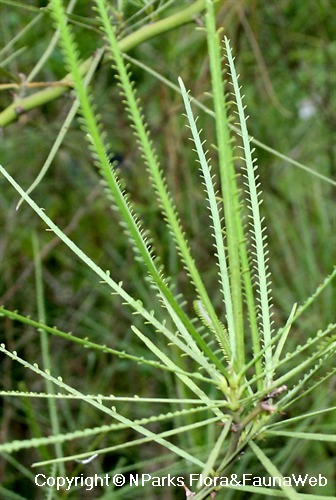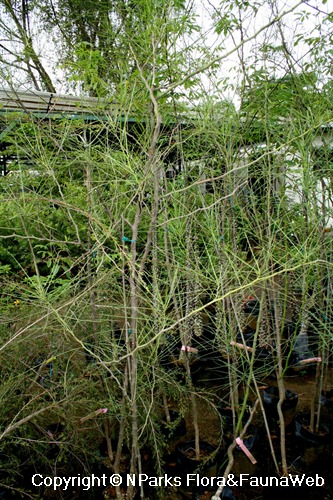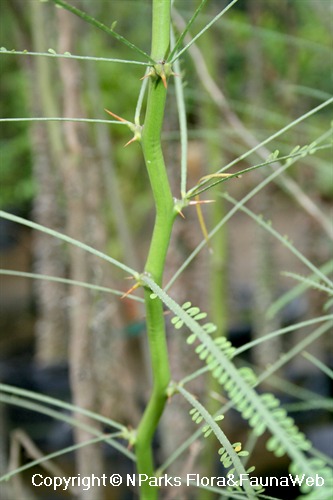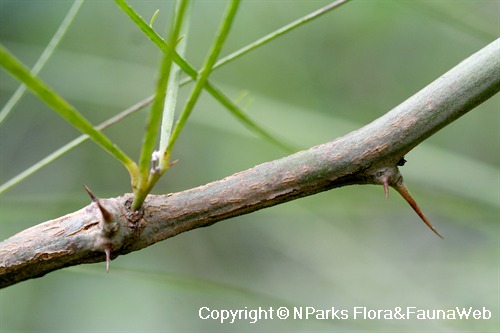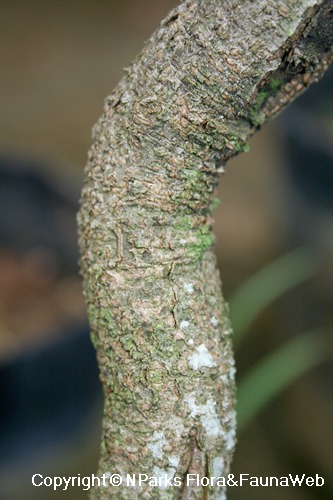
Back
Parkinsonia aculeata L.
| Family Name: | Fabaceae (Leguminosae) |
| Synonyms: | Parkinsonia thornberi |
| Common Name: | Jerusalem Thorn, Horse Bean, Mexican Palo-Verde, Jellybean Tree, Barbados Flowerfence, Retaima |
Name
Classifications and Characteristics
| Plant Division | Angiosperms (Flowering Seed Plants) (Dicotyledon) |
|---|---|
| Plant Growth Form | Tree (Medium (16m-30m), Small (6m-15m), Shrubby (1m-5m)) |
| Lifespan (in Singapore) | Perennial |
| Mode of Nutrition | Autotrophic |
| Plant Shape | Weeping / Pendulous, Open |
| Maximum Height | 4.5 m to 8 m |
| Maximum Plant Spread / Crown Width | 6 m to 7.5 m |
Biogeography
| Native Distribution | Southern USA, Mexico, Caribbean, Bolivia, Ecuador, Peru, Paraguay, Uruguay, Argentina |
|---|---|
| Native Habitat | Terrestrial (Grassland / Savannah/ Scrubland, Desert / Semi-Desert) |
| Preferred Climate Zone | Tropical, Sub-Tropical / Monsoonal |
| Local Conservation Status | Non-native |
Description and Ethnobotany
| Growth Form | It is a shrub or small tree, up to 4 m tall. Young shoots are armed with stiff prickles (up to 2-3 cm). |
|---|---|
| Foliage | Leaves are compound, bipinnate with flattened rachis. Leaflets are obovate shaped, very small (2 – 5 mm long and 1 mm wide) and subopposite to alternate arrangement. Stipules are modified into a pair of short spines, at the base of the petiole. |
| Flowers | Inflorescence occurs in the axillary position (up to 20 cm long). Flower has 5 golden petals with a hairy claw (12 – 14 mm long) where the median claw is longer than the lateral ones. Sepals are ovate to oblong and reflexed (5 – 7 mm long). Filaments are hairy near the bottom and widens towards the base. Ovary is hairy and subsessile with 6 – 15 ovules. |
| Fruit | Pod is yellowish, cylindrical (5 – 15 cm long and 0.5 - 0.7 cm wide) and split opens when mature, revealing 6 or more seeds within. Seed is oblong 10 mm long and 4 mm wide. |
| Ethnobotanical Uses | Edible Plant Parts : Edible Seeds Food (Fruit or Vegetable) Others: Native Americans dry and cook seeds over dry heat before consumption. Flowers are source of nectar, used as bee plant. Wood used as charcoal or firewood. |
Landscaping Features
| Desirable Plant Features | Ornamental Foliage, Ornamental Flowers, Fragrant (Flowers) (Day) |
|---|---|
| Landscape Uses | General, Focal Plant, Parks & Gardens |
| Thematic Landscaping | Rockery / Desert Garden |
| Usage Hazard - Cons | Spines/Thorns - Stem/Branch, Spines/Thorns - Trunk, Invasive / Potentially Invasive |
Fauna, Pollination and Dispersal
| Fauna Pollination Dispersal Associated Fauna | Butterfly-Attracting |
|---|---|
| Seed or Spore Dispersal | Abiotic (Explosive Dehiscence) |
Plant Care and Propagation
| Light Preference | Full Sun |
|---|---|
| Water Preference | Little Water |
| Plant Growth Rate | Fast |
| Rootzone Tolerance | Drought Tolerant, Well-Drained Soils, Poor Infertile Soils, Alkaline high pH Soils, Disease / Pest Resistant |
| Maintenance Requirements | Moderate |
| Propagation Method | Seed, Stem Cutting |
| Propagation Method Remarks | Plant produces 2 types of seeds within same pod -- 25% of light brown seeds that germinate readily. 75% of light brown seeds & all of dark brown seeds have hard seed coats, which must be scarified before sowing. |
Foliar
| Foliage Retention | Drought / Semi-Deciduous |
|---|---|
| Mature Foliage Colour(s) | Green |
| Mature Foliage Texture(s) | Smooth |
| Foliar Modification | Spine (axillary), Reduced / Needle-like |
| Foliar Type | Compound (Even-Pinnate) |
| Leaf Area Index (LAI) for Green Plot Ratio | 2.5 (Tree - Open Canopy) |
Non - Foliar and Storage
| Trunk Type (Non Palm) | Woody |
|---|---|
| Bark Colour(s) | Green, Brown |
| Mature Bark Texture | Scaly |
| Stem Type & Modification | Woody |
| Root Type | Underground (Tap Root, Fibrous Root) |
Floral (Angiosperm)
| Flower & Plant Sexuality | Bisexual Flowers |
| Flower Colour(s) | Yellow / Golden |
|---|---|
| Flower Symmetry | Bilateral |
| Flowering Habit | Polycarpic |
Fruit, Seed and Spore
| Mature Fruit Colour(s) | Brown |
|---|---|
| Fruit Classification | Simple Fruit |
| Fruit Type | Dehiscent Dry Fruit , Lomentum / Loment |
References
| References | Larsen, K., Larsen, S. S. & Vidal, J. E. . 1984. Fabaceae. Flora of Thailand. Bangkok, Thailand: The Forest Herbarium, Royal Forest Department. 4 (1): 1-129 |
|---|
Image Repository
Others
| Master ID | 29142 |
|---|---|
| Species ID | 3451 |
| Flora Disclaimer | The information in this website has been compiled from reliable sources, such as reference works on medicinal plants. It is not a substitute for medical advice or treatment and NParks does not purport to provide any medical advice. Readers should always consult his/her physician before using or consuming a plant for medicinal purposes. |


